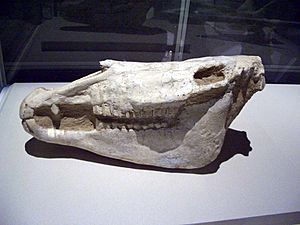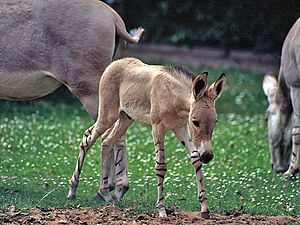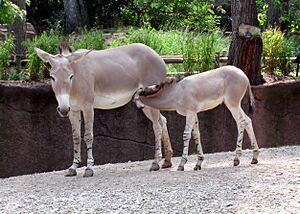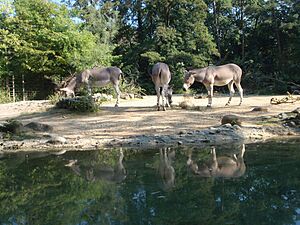African wild ass facts for kids
Quick facts for kids African wild ass |
|
|---|---|
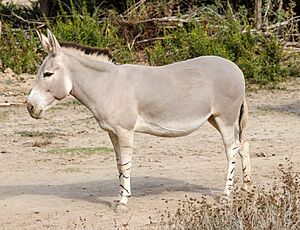 |
|
| Somali wild ass subspecies (Equus africanus somaliensis) | |
| Conservation status | |
| Scientific classification | |
| Genus: |
Equus
|
| Species: |
africanus
|
| Subspecies | |
|
E. a. africanus |
|
 |
|
| Geographic range | |
The African wild ass (Equus africanus) is a wild animal from the horse family, called Equidae. Many people believe this animal is the ancestor of the domestic donkey (Equus asinus). Sometimes, they are even considered the same species. African wild asses live in deserts and dry areas in the Horn of Africa. You can find them in Eritrea, Ethiopia, and Somalia. Long ago, they lived in more places, including Sudan, Egypt, and Libya. Sadly, they are Critically Endangered, with only about 570 left in the wild.
Contents
What Does the African Wild Ass Look Like?

The African wild ass stands about 1.2 meters (4 feet) tall. It weighs around 250 kilograms (550 pounds). Its fur is short and smooth, usually light grey to fawn. This color fades to white on its belly and legs.
All African wild asses have a thin, dark stripe along their back. The Nubian wild ass subspecies and domestic donkeys also have a stripe across their shoulders. The Somali wild ass has black stripes on its legs, which look a bit like a zebra's stripes.
On its neck, the African wild ass has a stiff, upright mane. The hairs on the mane have black tips. Its ears are large and have black edges. The tail ends with a black brush. Their hooves are thin and about the same size as their legs.
How Did the African Wild Ass Evolve?
The group of animals called Equus includes all modern horses, zebras, and donkeys. Scientists believe these animals evolved from an ancient creature called Dinohippus. One of the oldest known species in this group is Equus simplicidens. This animal looked like a zebra but had a donkey-shaped head. The oldest fossil found is about 3.5 million years old.
The Equus group quickly spread across the world. Modern equids, like the African wild ass, share a common ancestor from about 5.6 million years ago. This means they all came from the same ancient animal.
Types of African Wild Asses
Scientists sometimes consider the African wild ass and the domestic donkey as one species. Other times, they are seen as two separate species. The name Equus africanus is the correct scientific name for the wild ass. This helps avoid confusion with its descendant, the domestic donkey.
The African wild ass has three known subspecies:
Where Do African Wild Asses Live?
African wild asses are perfectly suited for life in deserts and dry areas. They have strong digestive systems. This helps them break down tough desert plants and get water from their food. They can also go a long time without drinking water. Their large ears help them hear very well and also help them stay cool.
Because there isn't much plant life in their homes, wild asses usually live apart from each other. The only exception is mothers and their young. This is different from wild horses, which often live in large groups. African wild asses have very loud voices. They can be heard for over 3 miles (5 kilometers). This helps them stay in touch across the wide-open desert.
Behavior and Life Cycle
The African wild ass is most active when it's cooler, from late afternoon to early morning. During the day, they look for shade and shelter among rocky hills. The Somali wild ass is very quick and good at moving across rocky areas and mountains. On flat ground, they can run as fast as 70 kilometers per hour (43 miles per hour). Their hooves are very hard and grow quickly to help with this.
Adult male wild asses protect large areas of land, sometimes as big as 23 square kilometers (9 square miles). They mark their areas with piles of dung. This is important in the flat desert. Because their territories are so big, dominant males can't keep all other males out. Instead, they let other males stay but keep them away from any females in the area. When females are ready to mate, the males will bray loudly. These animals live in loose groups of up to fifty individuals.
In the wild, African wild asses usually have their young during the wet season. A mother carries her baby for 11 to 12 months. One foal is born between October and February. The foal drinks its mother's milk for 6 to 8 months. They become old enough to have their own babies at about 2 years old. In zoos, they can live up to 40 years.
Wild asses can run very fast, almost as quickly as a horse. But unlike most hoofed animals, they don't run away right away from danger. They first check out the situation before deciding what to do. If they need to, they can defend themselves by kicking with both their front and back legs.
What Do African Wild Asses Eat?
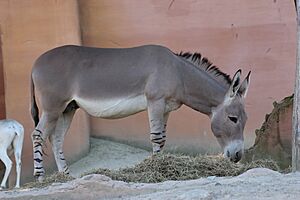
African wild asses eat grasses, bark, and leaves. Even though they are built for dry places, they need water. If they don't get enough moisture from their food, they must drink at least once every three days. However, they can survive on very little water. They have even been seen drinking salty water.
Why Are African Wild Asses Endangered?
While there are many domestic donkeys, the two wild subspecies of African wild ass are both critically endangered. For hundreds of years, people have captured wild asses to make them domestic animals. This, along with wild and domestic animals breeding together, has caused their numbers to drop a lot. Now, only a few hundred are left in the wild.
People also hunt these animals for food and for traditional medicine in Ethiopia and Somalia. Another problem is that domestic farm animals compete with wild asses for grass and water. New farms also limit their access to water.
African wild asses are legally protected in the countries where they live. But it's often hard to make sure these laws are followed. A protected group of Somali wild asses lives in the Yotvata Hai-Bar Nature Reserve in Israel. This reserve was started in 1968 to help endangered desert animals. If they are properly protected, wild ass populations can recover from their low numbers.
African Wild Asses in Zoos
Around 150 Somali wild asses live in zoos worldwide. Thirty-six of these were born at Zoo Basel in Switzerland. This zoo started its breeding program for this species in 1970, and the first baby was born in 1972.
Zoo Basel helps manage the breeding program for Somali wild asses in Europe. All European wild donkeys are either descendants of the first group at Zoo Basel or of 12 others that came from the Yotvata Hai-Bar Nature Reserve in Israel in 1972.
See also
- Endangered species
- Fauna of Africa
- Feral donkeys in Australia
- Asiatic wild ass




